DISCLAIMER
the content of these galleries is a private property
neither the text nor the pictures may be republished, nor used for any purpose, without the author's permission
 |
back to the
GALLERY INDEX |
~~ Gallery 5 ~~
The Tarot and other Early Cards
· page II ·
REGIONAL TAROTS - 5
Germany · Austria · Czech Republic
Hungary
|
back to the
GALLERY INDEX |
 |
other pages
I wish to thank Lóránt Kégl for his
help with the Hungarian glossary
GERMANY · AUSTRIA · CZECH REPUBLIC
TAROCK · TAROKY
The pattern adopted in central Europe (southern
Germany, Austria, Czech Republic, Slovakia), called Tarock in German
and Taroky in Czech, is somewhat similar to the French one, from which
it sprang, but it has only 54 cards.
Its set of trumps ( Trumpf) consists of 21 subjects and a joker called
Sküs (Czech kýz), obviously born from the French Excuse,
described in part 3. |
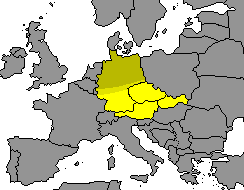 |
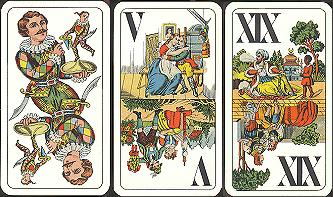
the Sküs card and two trumps, from a
Tarock deck by ASS (Germany) |
The trumps are not too different from the ones of the French Tarot,
double-headed, with couplets of genre scenes matched along the horizontal division line; the large number
above, though, is spelt in roman numerals, located in a corner, with no
decoration nor flourish.
The Sküs is not numbered; it features a harlequin or jester in
the curious attitude of holding a hat on top of which a similar but much tinier jester balances.
|
Comparing the scenes featured by the trumps of this deck with the ones of the Tarot,
remarkable differences can be told, since the themes of the French scheme are
not followed.
Subject no. I (see picture at the bottom of the page)
features a girl playing a tambourine and, on the opposite side, a fool playing a xylophone:
this card is usually referred to as Pagat,
after the Italian tarot's first trump il Bagatto, literally "the
trivial performer".
In subject no. II, an eagle with a sword pouches on a rock that bears
the words Industrie und Glück ( "Industry and Luck", see also the
expressions gallery): for this
reason, the standard German/Austrian Tarock pattern is often referred to
with this name. However, in its Czech editions this card does not feature any text
at all. |
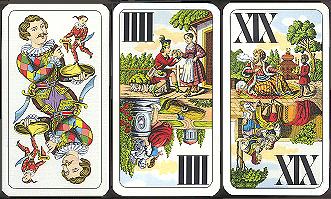
sample from a Tarock deck by Piatnik (Austria) |
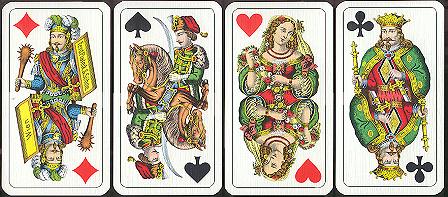
some courts from a Tarock deck by Piatnik (Austria) |
The pip cards of the Tarock are reduced; in fact, only values
from 1 (ace) to 4 of the red suits (Diamonds and Hearts), and from 7 to 10 of the black ones
(Spades and Clubs) are needed for the game. These cards bear no
indices.
|
The court cards are the same ones as in any other tarot,
i.e. knave, cavalier, queen and king. Their
illustrations are closer to the ones found in German-suited patterns than
to the French Tarot's design (see the German
and Austrian galleries for
reference).
The knave of Diamonds and the one of Clubs feature the manufacturer's
name on the rectangular and oval shields they respectively carry.
|
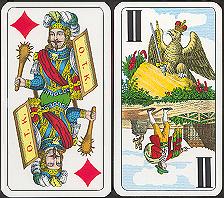
knave of Diamonds and trump II
from a Taroky deck by O.T.K. (Czech Rep.) |
During the 19th century, several fancy editions of the Tarock were issued; in most of these decks the traditional double illustrations of the trumps were replaced with city views.
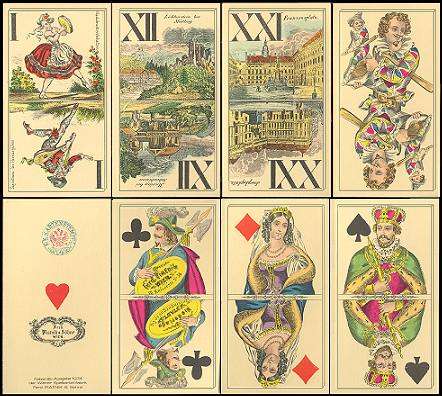
Wiener Veduten Tarock
The sample shown above comes from the Wiener Veduten Tarock ("views of Vienna tarot"), first issued around 1870 by Piatnik (Austria), and reprinted in 1974 by the same manufacturer, on the occasion of the 150th anniversary of Piatnik's firm.
The fine etchings, coloured by stencil with watercolour paints, depict forty views of the city's most important buildings, monuments and establishments. The Pagat (i.e. trump no.I), the Sküs
and the suit cards are traditional. |
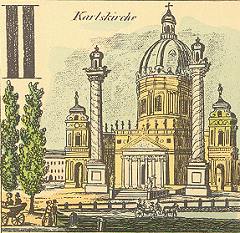
detail from trump no.II: "Karlskirche" |
CEGO TAROCK
The area of the Schwartzwald or Black Forest,
in Baden-Württenberg (south-western Germany, by the French and Swiss border),
adopted an interesting variety of tarot cards for the
game of Cego. The pattern too is known with the same name, which
may have a Spanish or Portuguese origin.
In fact,
in this game some extra cards called Blinde
("blind, blindfolded") are dealt in the center of the table
for the players to bid on; this likely derived from the early game
of L'Hombre (17th century Spanish game), and
in Spanish the word ciego, or cego in Portuguese,
actually means "blind".
The pattern was probably created around the mid
19th century, as suggested by the earliest literary
record, consistent with this dating.
|
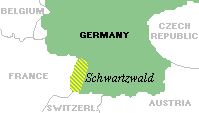 |
The Cego Tarock may be considered a hybrid between the standard
Tarock described above and the French Tarot.
It has 54 cards, as the former deck.
The set of trumps, here called Trocks or Trocke (a further name
is Stecher), consists of the usual 21 numbered subjects, plus a numberless Sküs (joker).
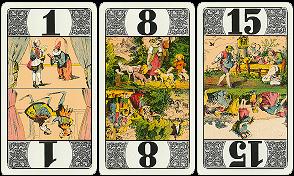
trumps from the Cego tarot by F.X.Schmid (Germany) |
At present, the Cego Tarock is made by the
two leading German manufacturers, F.X.Schmid and ASS, whose editions
bear quite different illustrations.
In Schmid's version these cards features couplets of genre scenes, inspired by
everyday's life, similar to the French scheme, though not fully matching it
(see part 2). On each side, above the illustration
is a large Western numeral, placed centrally and enclosed by a black and white
flourish, as in most Tarot editions. |
Instead, in the edition by ASS, called Adler-Cego
("eagle Cego"), the couplets mainly show animals, from common
ones (pig, mule, etc.) to exotic species (rhinocerus, elephant, and others);
curiously, there is no eagle among these subjects, as the name of the deck may
wrongly suggest. The numerals are Western, in the center of a salmon-coloured
rectangle, but without any flourish nor frame.
In both editions each
card's couplet suggests a contrast. F.X.Schmid's set recalls
the French scheme: various themes, such as the ages of life, the seasons of the year, etc.,
are represented as indoors and outdoors scenes, or with male and
female personages, and so on. Instead in the version by ASS, a farm animal matches a
wild one (i.e. pig and boar), or a humble one pairs off with a more noble one
(i.e. mule and steed), a lion is shown at rest and while hunting,
a brown bear is opposite to a polar bear (white), and so on. |
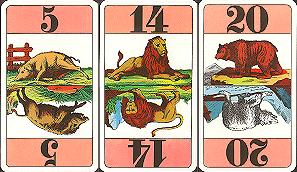
trumps from the Adler-Cego edition by ASS (Germany) |
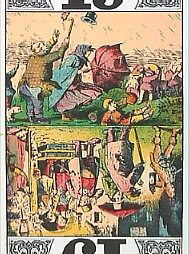
detail of trump no.19 (winter),
Cego Tarock by F.X.Schmid |
The Pagat (trump no.1) is sometimes called der kleine Mann ("the small man").
Also the Sküs or joker has an alternative name, Stieß or
Gstieß; it looks very similar to the French Excuse, and features
a minstrel playing a lute.
The suit cards are the same ones as in the standard Tarock:
Diamonds and Hearts run from 1 (ace) to 4, while Clubs and Spades run from 7 to 10.
|
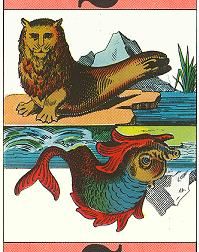
Adler-Cego: detail of trump no.2
(sea-lion / sea monster) |
The design of the court cards varies according to the maker. The illustrations
in F.X.Schmid's version are surely closer to the French
Tarot, but the
numeral index is missing, as in ordinary German
Tarock decks. The
courts in the edition by ASS are reminiscent of the ones found in
the
Württenbergisches Bild (i.e. the
local regional pattern), but they partly resemble also those of the French-suited
Jass cards
used in Switzerland. In both cases, the pip cards are identical, and
have no index at all.
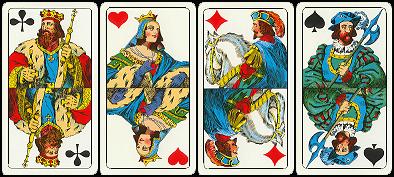
(above) Cego courts from F.X.Schmid's edition;
(below) the same subjects by ASS are completely different
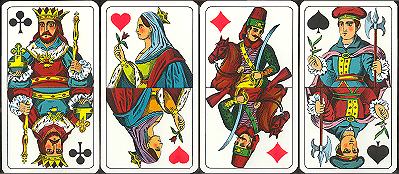 |
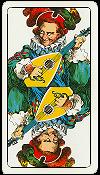
the Sküs, by F.X.Schmid (left)
and ASS;
(below) Cego pip cards, by F.X.Schmid
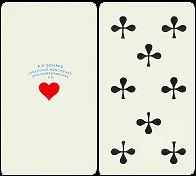 |
|
more samples of "der Sküs"
can be seen in Bo Bernville's website
Tarock
HUNGARY
Due to close relations with the German culture, Hungary too uses a regional deck named
Tarokk, which apparently looks very similar to the standard German/Austrian
Tarock.
There are indeed many elements of similarity, and the joker is called
Skíz (this name is basically the same Sküs spelt
according to the Hungarian pronounciation), identical to the German one. The
courts too are the same ones found in a standard Tarock.
Also the trumps may seem identical; but at a closer look, only about
half of the Tarokk's illustrations are the same as the
German ones. Some subjects mismatch, but there are also scenes
whose rank is different in the two versions:
for instance, one of the two illustrations of the
German trump no. XVI shows a woman holding a child while a man plays a pipe;
an identical scene is found on the Hungarian trump no. XIX.
Also in the Hungarian version trump no. I is called pagát,
while no. II is referred to as sas ("eagle"), no. III as kakadu ("cockatoo, parrot"),
and no. IIII as kanári ("canary").
The Tarokk deck is more often produced in a 42-card version: in fact the
most popular game played with the Tarokk, called Paskievics, only requires
four pip cards: two red aces (Diamonds and Hearts) and two black 10s (Diamonds and Clubs);
the usual four courts in each suit, the 21 trumps and the Skíz card
make the rest of the pack.
|
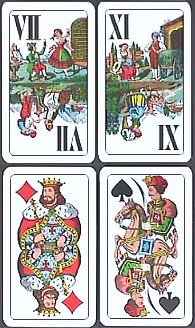
samples of Tarokk deck, by
Játékkártya Nyomda (Hungary) |
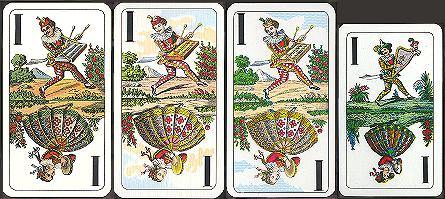
two comparative samples of trumps taken from German, Austrian, Czech and Hungarian tarots: the one in the top row is the Pagat;
only some of the Hungarian subjects (far right) match the scenes featured by the other national versions
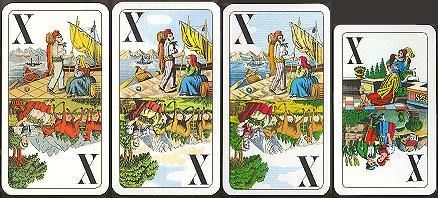
further reference to tarot decks can be found in Trionfi and in
The Hermitage
| TAROCK | TAROKY | TAROKK | TAROT |
|---|
| TRUMPFKARTEN | TAROKY | TAROKKOK | TRUMPS |
|---|
| FARBKARTEN | FARBY | SZÍNES LAPOK | SUIT CARDS |
|---|
| FARBEN | FARBY | SZÍNEK | SUITS |
|---|
| KARO | KÁRA | KÁRÓ | DIAMONDS |
|---|
| HERZ | SRDCE | KÕR | HEARTS |
|---|
| PIK | PIKA | PIKK | SPADES |
|---|
| KREUZ | KRÍ E (cross) E (cross) | TREFF | CLUBS |
|---|
| AS | ESO | ÁSZ | ACE |
|---|
| FIGURENKARTEN | FIGÚRY | FIGURÁK | COURT CARDS |
|---|
| BUBE | DOLNÍK | BUBI / BOTOS | KNAVE |
|---|
| REITER / KAVALL | JAZDEC | LOVAS | CAVALIER |
|---|
| DAME | DÁMA | DÁMA | QUEEN |
|---|
| KÖNIG | KRÁL | KIRÁLY | KING |
|---|
| SKÜS | KÝZ | SKÍZ | EXCUSE (JOKER) |
|---|
OTHER GALLERIES






















or back to

INTRODUCTION
AND HISTORY
|

MULTI-LANGUAGE
GLOSSARY |

THE FOOL &
THE JOKER |

INDEX
TABLE |

REGIONAL
GAMES |

PLAYING CARD
LINKS |